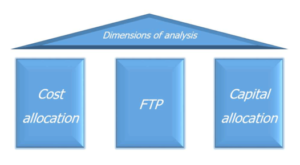by Melania Franzese & Giordano Di Veglia
The powerful acceleration of the dynamics linked to digital transformation has once again challenged the banks’ business models, forcing the supervisor to make a qualitative leap in analysing the business models and profitability in the banking strategic process. In this context, the ability of banks to adopt appropriate assessment methodologies for their business models is even more crucial.
In the context of biodiversity of business models to achieve the profitability and the resilience in the medium to long term, business model analysis should be interpreted not so much as a means of arriving subsequently at a measurement and identification of the economic drivers assumed, but rather as a methodology to control and steer the industrial process in the most efficient and profitable way possible.
Identifying the business segments that contribute to the creation/destruction of value in the medium to long term, together with the opportunities to exploit FinTech, are undoubtedly among the most challenging activities for bank management. Making decisions consistent with corporate sustainability is now an unavoidable step that banks must face both in business as usual and even more so in the new environment.
In the current environment, banks’ business models are evolving along three different lines:
- Bank as Fintech (the bank embraces new technologies and competes directly as Fintech).
- Platform bank (the bank integrates its own or third-party Fintechs while maintaining its privileged access to the customer).
- Bank as provider of Fintechs (the bank becomes a service provider for the Fintechs which control the relationship with the customer).
Looking at bank balance sheets, it emerges that digitalisation is already impacting on the performance of commercial banks where a cost reduction path can be observed due to a higher degree of automation and a certain shift of revenues towards operators that are more efficiently and effectively able to meet customers’ needs.
They observed the increased integration of digital and physical (phygital) channels along two major lines. On the one hand, the optimisation of the back end, to allow flexibility in the composition of the product and service offering. On the other hand, the restructuring of a front end, which offers basic products, such as a payment account, within the customer’s shopping experience (e.g. for obtaining a good or service) and instead offers value-added financial services (e.g. advisory services) within the financial value chain.
At the centre remains the customer around whom banks are developing customer experience analysis techniques in order to better understand their needs.
But if the opportunities are more or less already clarified by market players, on the other hand, it is not so easy to foresee the real (or virtual) threats and the effects, in terms of strengths and weaknesses, on each business model, which will depend on the role the bank will choose to play in the current digital transformation process.
Innovation is not risk-free: the financial industry will therefore have to carefully take into account in the process of rethinking business models the emerging risks associated with digitalisation, also with regard to the fact that certain activities are not yet regulated.
From this perspective, the inseparable link between strategic success and governance, segment reporting and fund transfer pricing continues to be relevant.
The mix of resources, products and customer segments that characterise the business model of banks cannot be separated from the need to fully develop or “rethink” the three main dimensions from which to carry out a complete BM analysis, as well as from a robust management control system.
In order to channel entrepreneurial initiatives to where more wealth is created, it is also necessary to reprocess that data in a granular way so that it can be interpreted ex ante by bank management.
Along these lines, the cost allocation process should be reviewed and capital allocation better measured.

The processes of cost allocation, fund transfer pricing and capital allocation in the challenging context will have to be embedded in a broader assessment framework, where the internal governance process will play a crucial role as a dialectical and proactive contribution to the business strategy. Also the coordinated functioning of the mechanisms for transmitting strategic impulses and the ability to translate strategic and operational decisions into action, in an effective and timely manner will be vitally important.
In fact, contrary to common opinion, the failure of a planning process is often attributable more to a lack of or poor monitoring of business execution than to the soundness of the business strategy itself.
The book “Business Model and Profitability in the banking strategic process: focus on digitalisation“ deals extensively with these issues.
The opinions expressed by the authors are personal and do not in any way engage the responsibility of the institute they belong to.
Melania Franzese is an Adviser for the Banking and Financial Supervision Department at the Bank of Italy. Giordano Di Veglia is the Director of the Banking and Financial Supervision Department at the Bank of Italy.






